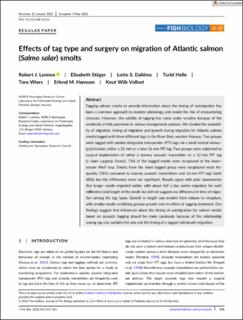| dc.contributor.author | Lennox, Robert | |
| dc.contributor.author | Stöger, Elisabeth | |
| dc.contributor.author | Dahlmo, Lotte Svengård | |
| dc.contributor.author | Helle, Turid Myklebust | |
| dc.contributor.author | Wiers, Tore | |
| dc.contributor.author | Hanssen, Erlend Mjelde | |
| dc.contributor.author | Vollset, Knut | |
| dc.date.accessioned | 2022-10-03T13:33:58Z | |
| dc.date.available | 2022-10-03T13:33:58Z | |
| dc.date.created | 2022-09-23T10:48:24Z | |
| dc.date.issued | 2022 | |
| dc.identifier.citation | Journal of Fish Biology. 2022, 101 (3), 515-521. | en_US |
| dc.identifier.issn | 0022-1112 | |
| dc.identifier.uri | https://hdl.handle.net/11250/3023418 | |
| dc.description.abstract | Tagging salmon smolts to provide information about the timing of outmigration has been a common approach to monitor phenology and model the risk of encountering stressors. However, the validity of tagging has come under scrutiny because of the sensitivity of this parameter in various management systems. We studied the probability of migration, timing of migration and growth during migration for Atlantic salmon smolts tagged with three different tags in the River Dale, western Norway. Two groups were tagged with passive integrated transponder (PIT) tags via a small ventral nonsurgical incision, either a 12 mm or a new 16 mm PIT tag. Two groups were subjected to surgical implantation of either a dummy acoustic transmitter or a 12 mm PIT tag (a sham surgery). Overall, 71% of the tagged smolts were recaptured at the downstream Wolf trap. Smolts from the sham tagged group were recaptured most frequently (78%) compared to dummy acoustic transmitters and 16 mm PIT tags (both 68%), but the differences were not significant. Results agree with prior assessments that longer smolts migrated earlier, with about half a day earlier migration for each millimetre total length of the smolt, but did not suggest any difference in time of migration among the tag types. Growth in length was evident from release to recapture, with smaller smolts exhibiting greater growth and no effect of tagging treatment. Our findings suggest that inferences about the timing of outmigration for salmon smolts based on acoustic tagging should be made cautiously because of the relationship among tag size, suitable fish size and the timing of a tagged individual's migration. | en_US |
| dc.language.iso | eng | en_US |
| dc.rights | Navngivelse 4.0 Internasjonal | * |
| dc.rights.uri | http://creativecommons.org/licenses/by/4.0/deed.no | * |
| dc.title | Effects of tag type and surgery on migration of Atlantic salmon (Salmo salar) smolts | en_US |
| dc.title.alternative | Effects of tag type and surgery on migration of Atlantic salmon (Salmo salar) smolts | en_US |
| dc.type | Peer reviewed | en_US |
| dc.type | Journal article | en_US |
| dc.rights.holder | © 2022 The Authors | en_US |
| dc.description.version | publishedVersion | en_US |
| cristin.ispublished | true | |
| cristin.fulltext | original | |
| cristin.qualitycode | 1 | |
| dc.identifier.doi | 10.1111/jfb.15116 | |
| dc.identifier.cristin | 2054713 | |
| dc.source.journal | Journal of Fish Biology | en_US |
| dc.source.volume | 101 | en_US |
| dc.source.issue | 3 | en_US |
| dc.source.pagenumber | 515-521 | en_US |

